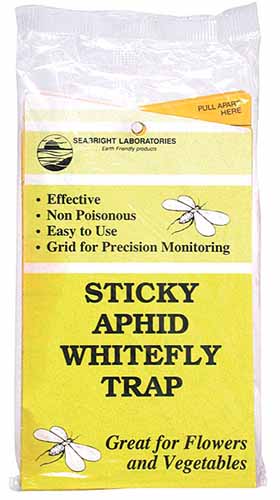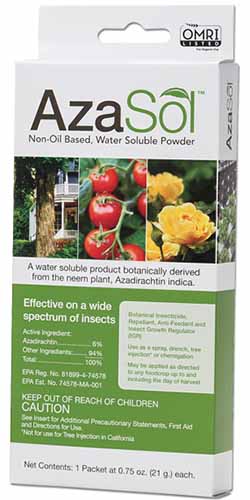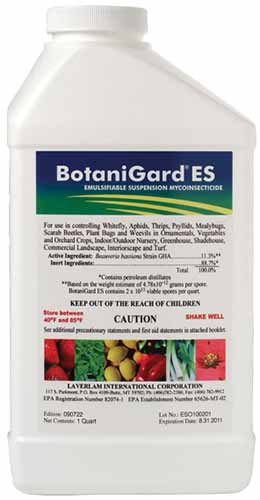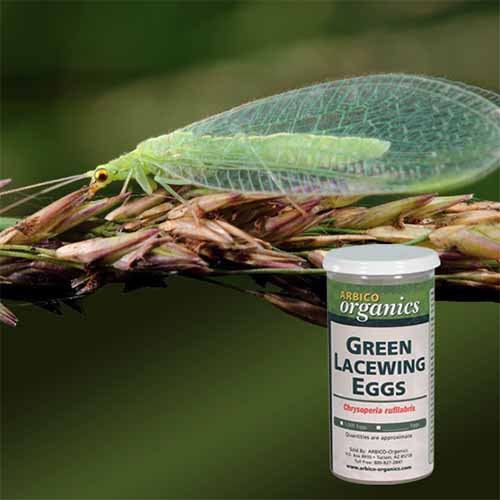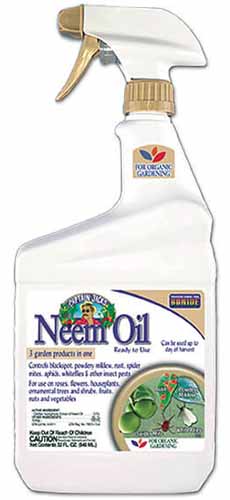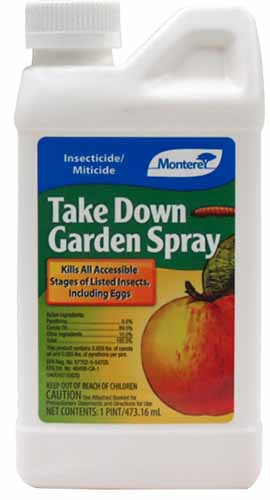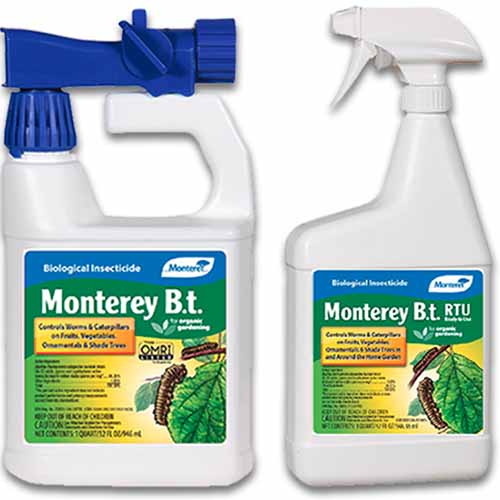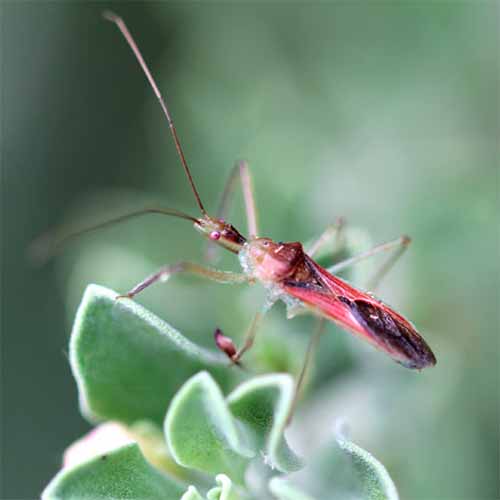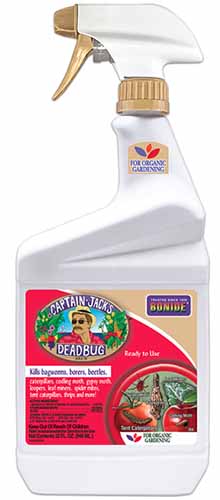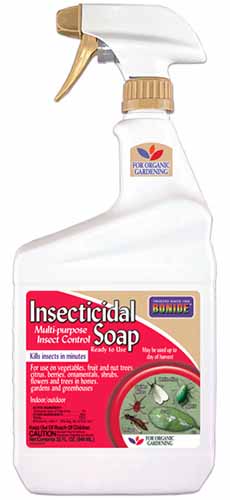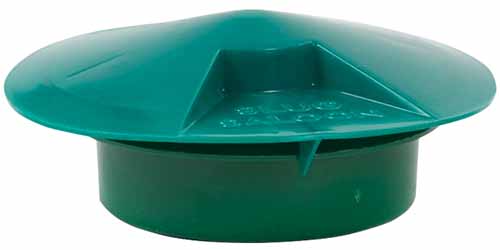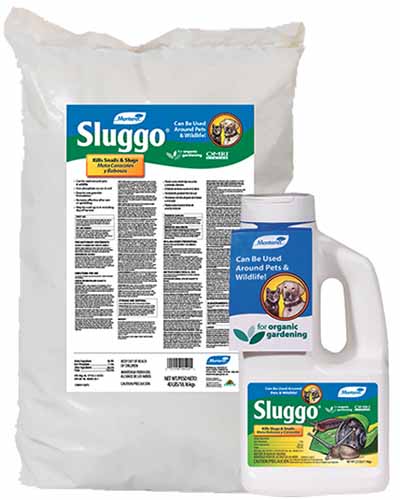
Pansies, Viola × wittrockiana, are cheerful bedding plants with five-petaled, face-like flowers in a wide range of single hues and multicolor combinations.
Suited to cultivation in Zones 6 to 10, pansies are members of the violet family, classified as short-lived evergreen perennials often grown as annuals.
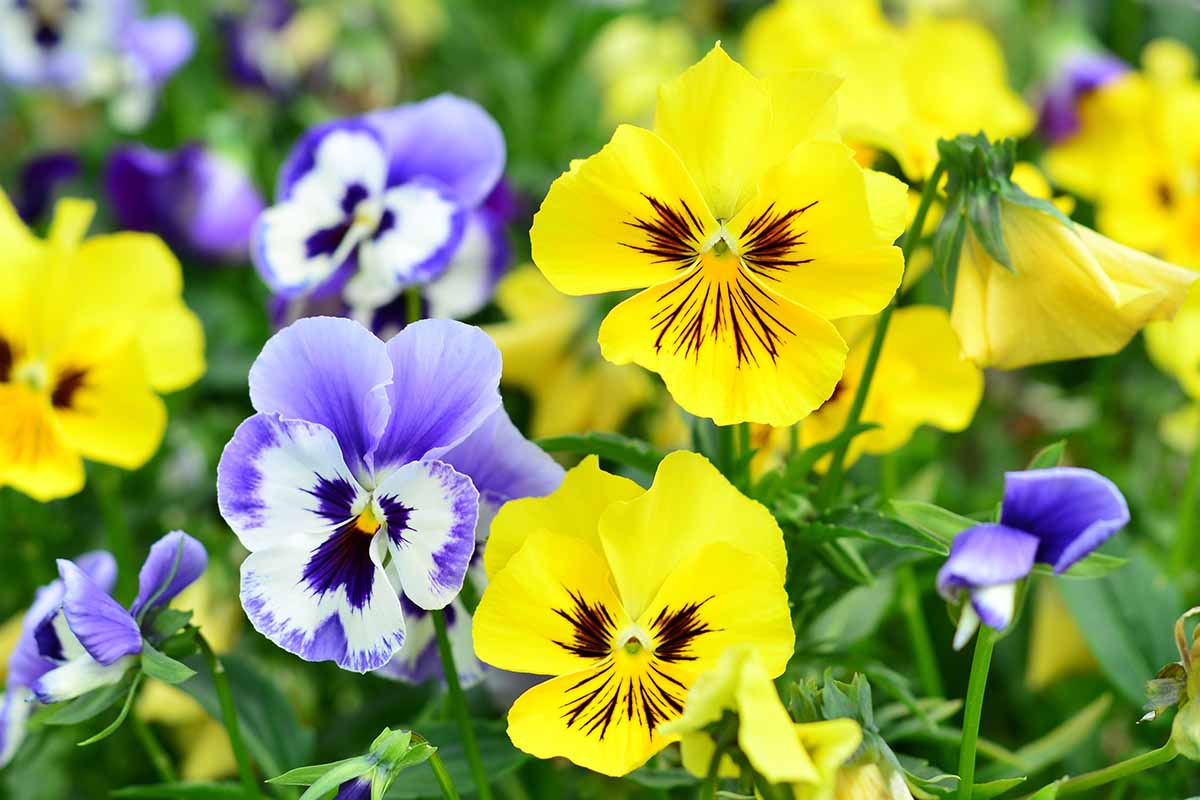
We link to vendors to help you find relevant products. If you buy from one of our links, we may earn a commission.
Cultural requirements include organically rich, moist, well-draining soil and a location with full sun to partial shade.
Our guide to growing pansies has all you need to know to enjoy plants in your outdoor living space.
This article discusses nine pests you may encounter while you are growing pansies, including their physical characteristics, avoidance measures, and treatment options.
Here’s what we’ll cover:
Let’s get ready to battle these bugs!
While pansies are not especially prone to pests, factors like moisture stress and proximity to affected plants may make them vulnerable to infestation.
In addition to causing disfigured foliage, insects that feed on pansies may carry diseases that cause severe damage and even plant death. Let’s look at nine of the most common culprits.
1. Aphids
Aphids are soft-bodied sapsuckers that destroy plant tissue with their chewing mouthparts, secreting toxins that disfigure foliage, causing it to become misshapen, yellow, and stunted.
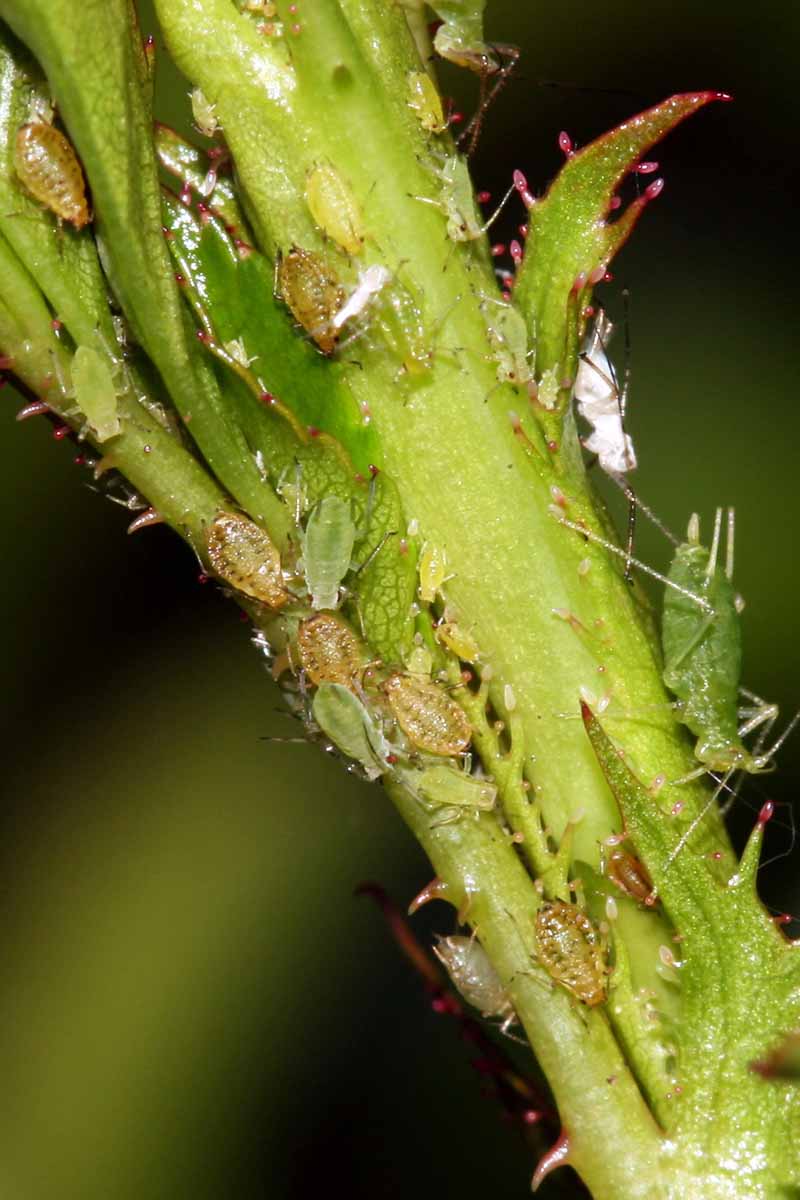
In addition, their sticky excrement known as honeydew is a perfect breeding ground for a fungal condition called sooty mold.
Cultural Controls
Avoid overfertilizing your pansies and the use of high nitrogen products that promote overly lush foliage attractive to aphids.
Inhibit stressors like too much or too little water that render pansy plants more vulnerable to attack.
Interplant pansies with aromatic herbs like dill and fennel that can deter aphids.
Keep the weeds down to avoid increasing the number of available host plants.
Lay silver mulch around plants. The reflective surface acts as an effective deterrent.
Space plants generously to avoid increasing the ambient humidity around plants which may promote the development of fungal disease.
Mechanical Controls
Apply food-grade diatomaceous earth around your pansies, a natural insecticide made of fossilized marine life that causes fatal injuries to aphids.
Unfortunately, it also harms bees and butterfly larvae, so avoid applying it directly to flowers visited by pollinators and relocate the larvae of desirable butterflies, like monarchs and swallowtails, to other plants before use.
Safer Brand Diatomaceous Earth Insect Killer
Safer Brand Diatomaceous Earth Insect Killer is available from the Safer store via Amazon.
Place insecticide-free yellow sticky traps near pansy plants to attract and trap pests.
These traps have grids useful to greenhouse growers who want to monitor aphid populations. They do not attract beneficial insects.
Aphid/Whitefly Yellow Sticky Traps
Aphid/Whitefly Yellow Sticky Traps are available from Arbico Organics.
Use a firm spray from the garden hose to dislodge pests before turning to other treatment options.
Organic Controls
Azadirachtin is a broad-spectrum organic insecticidal extract derived from neem tree seeds that kills aphids in all life stages.
Unfortunately, in addition to treating aphids on your pansies, it also kills beneficial insects and is toxic to people, pets, and marine life.
AzaSol is an azadirachtin product that kills and repels aphids, caterpillars, mealybugs, scale, and whiteflies in all life stages.
AzaSol is available from Arbico Organics in quarter-ounce, three quarter-ounce, one-pound bottles, and two-pound jug sizes.
Beauvaria bassiana is a beneficial fungus that is an effective insecticide because it causes white muscadine, a disease deadly to many pests, including aphids.
BotaniGard® ES contains Beauvaria bassiana and is an effective option for large, heavily-infested beds.
BotaniGard® ES is available from Arbico Organics.
Natural predators like green lacewings and ladybugs feed on aphids and can reduce populations.
Green lacewing, Chrysoperla rufilabris, larvae withstand greater temperature ranges and humidity than ladybugs and may be a better choice for some gardeners.
In addition, introducing predatory insects is more effective in a polytunnel or greenhouse than in a garden setting.
Green lacewing larvae are available from Arbico Organics in quantities ranging from 1.000 to 250,000.
Organic insecticidal soap, a few drops of liquid dish detergent in two cups of water, or horticultural neem oil knock down aphids by suffocating them.
Neem oil applied to your pansies in early spring may prevent overwintered eggs from hatching. It is also effective against sooty mold.
Bonide® Neem Oil is available from Arbico Organics.
Chemical Controls
Broad-spectrum insecticides are available but are generally not warranted in a home garden setting. These include:
Synthetic organophosphate insecticides such as acephate and malathion may prove effective but are toxic to bees, beneficials that may feed on aphids, marine life, pets, and people.
Synthetic pyrethroid insecticides containing permethrin, cyfluthrin, or bifenthrin may be an effective last resort.
Pyrethroids are synthetic products that simulate the naturally occurring pyrethrins in chrysanthemums. Unfortunately, they are toxic to marine life, people, pets, and beneficial insects, including bees.
See our guide to aphids for more information.
2. Beetles
Many types of beetles feed on vegetable crops and ornamentals, especially when the weather is warm, dry, and wind-free.
And while their colors vary, they all jump, have shiny shells, and leave rounded, irregular holes and pitting where they chew foliage.
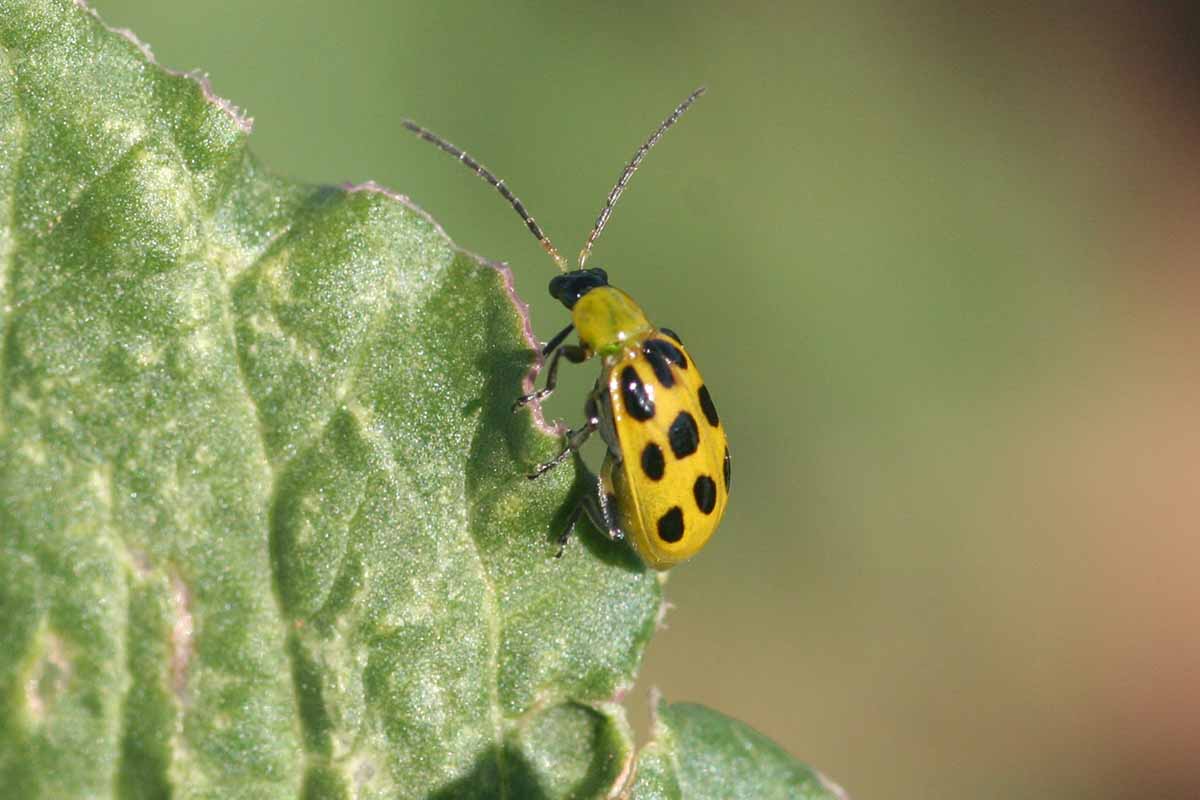
One of the most likely species to dine on your pansies is the spotted cucumber beetle, Diabrotica undecimpunctata.
The adults feed on the pansy blossoms and leaves, while the white larvae eat the roots. Young plants are especially vulnerable to root damage.
Cultural Controls
Avoid planting your pansies near vegetable crops.
Deter the pests with reflective silver mulch. For new beds, cover the soil with mulch and cut planting holes six to 12 inches apart to accommodate mature dimensions.
For existing gardens, install mulch around the perimeter.
Silver Black Metallic Mulch is more of a landscape fabric than mulch. It reflects light back to growing plants and creates a barrier to underground reproduction and root feeding.
Silver Black Metallic Plastic Mulch
Silver Black Metallic Mulch from the HFS store is available via Amazon in several sizes.
Keep the garden free of weeds that may harbor beetles from year to year.
Water your pansies adequately to avoid overly dry conditions.
Mechanical Controls
Hand-pick and destroy the beetles as you see them.
Net your pansies to protect them from a neighboring infestation.
Place sticky traps in the vicinity of an outbreak.
Spread diatomaceous earth over the soil to inhibit egg-laying and larval development.
Organic Controls
Apply neem oil on the foliage and the soil around the near the pansies as a deterrent. It is not an effective treatment during infestation.
Beauvaria bassiana is a fungal pathogen that causes white muscadine, a disease deadly to beetles.
Entomopathogenic beneficial nematodes kill larvae in the soil resulting in less root feeding and fewer adults.
NemaSeek™ contains the species Heterorhabditis indica that attacks beetle pupae in the soil, killing them before they can emerge as adults.
NemaSeek is available from Arbico Organics in packages of five million.
Parasitic predators like big-eyed bugs, damsel bugs, lacewings, and parasitic wasps that feed on flea and other beetles help to reduce populations.
Organic pyrethrins not blended with synthetics may be effective in the short term, but beetles are not stationary, and reapplications are likely necessary. Also, they harm bees and the beneficials that may otherwise feed on beetles.
Monterey Take Down Garden Spray contains pyrethrins, derived from Chrysanthemum cinerarifolium, and quickly knocks down insect populations.
It contains canola oil, making it suitable for use as a preventative spray during beetles’ winter dormancy.
Monterey Take Down Garden Spray
Monterey Take Down Garden Spray is available from Arbico Organics in a 32-ounce ready-to-use bottle and pint and gallon concentrates.
Products containing spinosad are effective but harm bees and beneficials.
Chemical Controls
Malathion, is a synthetic organophosphate broad-spectrum insecticide is effective, but it’s likely to destroy beneficials as well as the target beetles, and is toxic to marine life, pets, and people.
Synthetic pyrethroids containing cyfluthrin or permethrin are effective but toxic to people, pets, marine life, and beneficials.
3. Caterpillars
Many butterflies and moths are considered to be beneficial pollinators. Those that lay their eggs on pansies include cutworm moths, fritillary butterflies, leaf tier moths, and looper moths.
Unfortunately, when the larvae, known commonly as caterpillars, hatch, they feed on the pansy foliage, leaving telltale signs such as irregularly chewed holes, folded-over leaves, and stunted growth.
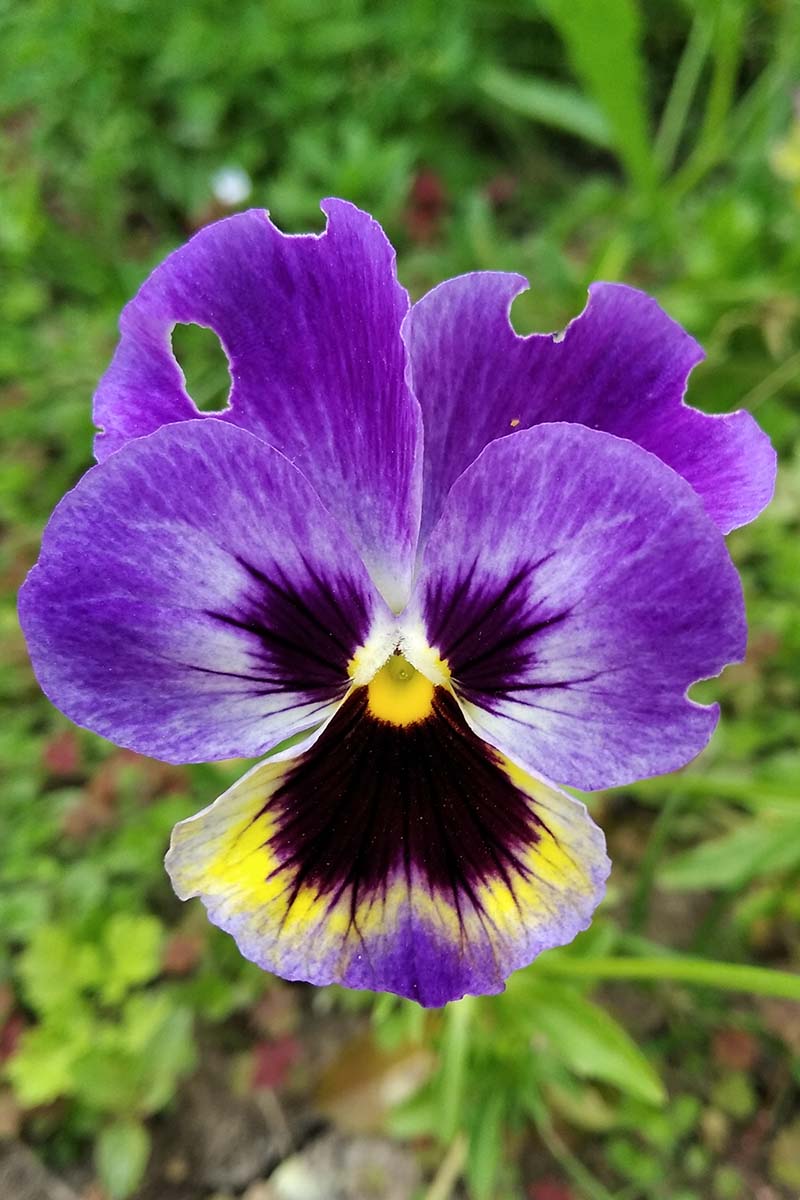
Caterpillars prefer temperate weather. Their colors vary widely, including black, brown, cream, gray, orange, pink, tan, variegated, and yellow.
Many species feed visibly during the day, but others, like cutworms, are active at night.
Cultural Controls
Grow your pansies away from other susceptible ornamentals and vegetables.
Keep the garden free of pest-harboring weeds.
Mechanical Controls
Hand-pick and destroy caterpillars as you see them.
Install feeders and houses that attract caterpillar-eating birds, like warblers, vireos, and grosbeaks.
Use garden netting to cover your pansies if caterpillars appear on nearby flora and remove it when the infestation is under control to restore the aesthetic appeal of pansy flowers.
This 0.4-inch ultra-fine fine garden mesh may be all you need to keep caterpillars at bay while you work on eradicating a nearby infestation.
Ultra-Fine Mesh Garden Netting
Ultra-Fine Mesh Garden Netting is available from the RIFNY store via Amazon.
Choose from five by 10 feet, eight by 24 feet, 10 by 20 feet, or 10 by 33 feet. Each package comes with two nets of equal size.
Organic Controls
Azadirachtin, mentioned above, kills caterpillars but is also toxic to beneficials, marine life, people, and pets.
Bacillus thuringiensis subspecies kurstaki (Bkt) is a microbial insecticide that does no harm to people, pets, marine life, or beneficial insects.
Apply it as soon as the caterpillars hatch for best results. You can read more about Bt in our guide.
Btk controls most caterpillars, causing feeding to cease minutes after application for a quick knockdown of pest populations.
Monterey Bt Liquid is available from Arbico Organics.
Choose from ready-to-spray and hose-end concentrated products.
Beauvaria bassiana is also effective against caterpillars.
Neem oil is an organic extract from neem tree seeds that is fungicidal, insecticidal, and miticidal. It kills caterpillars at all stages, from egg to adult.
You can also release beneficial insects that feed on egg-stage larvae, like assassin bugs, lacewings, and ladybugs.
Assassin bugs, Zelus renardii, are predators that ambush and kill prey like aphids, caterpillars, and mealybugs. Releasing predatory insects achieves the best results in a greenhouse setting.
Assassin Bugs are available from Arbico Organics in packages of 250, 500, 1,000, 2,000, and 5,000.
Spinosad, Saccharopolyspora spinosa, is a naturally-occurring insecticide produced by soilborne bacteria that effectively kills caterpillars.
Bonide® Captain Jack’s Deadbug Brew™ contains spinosad.
As spray formulations are toxic to beneficial bees, applying when bees are not active is an effective way to protect them, as once dry, the product poses no danger.
Bonide Captain Jack’s Deadbug Brew
Bonide® Captain Jack’s Deadbug Brew™ is available from Arbico Organics as a 32-ounce ready-to-use spray, 32-ounce hose-end ready-to-use spray, 16-ounce concentrate, and 32-ounce concentrate.
Chemical Controls
Broad-spectrum synthetic pyrethroid insecticides are effective against caterpillars but are toxic to people, pets, marine life, and beneficial insects that may feed on larvae.
Pyrethroids are synthetic versions of naturally occurring insecticidal compounds called pyrethrins. Apply at the egg or larvae stage.
4. Gall Midges
Violet gall midge, Prodiplosis violicola, is one of many species of gnat-like flying midges.
The immature larvae are maggot-like and may be orange, red, white, or yellow. They bore into pansy foliage, creating bump-like galls inside which they live and feed.
In addition to forming galls, violet gall midge feeding causes leaf curling and splitting.
Once a significant threat to the floriculture industry, populations of the species have recently waned. Unless a commercial greenhouse is infested, and you purchase an infected pansy plant, it is unlikely you’ll face this pest.
If your pansies have gall-disfigured foliage, remove and dispose of affected portions. Insecticidal treatments generally prove ineffective.
5. Mealybugs
Mealybugs are a soft-bodied type of scale, an insect we discuss below. They are wingless sapsuckers with a waxy exterior and a preference for warm, dry environments.
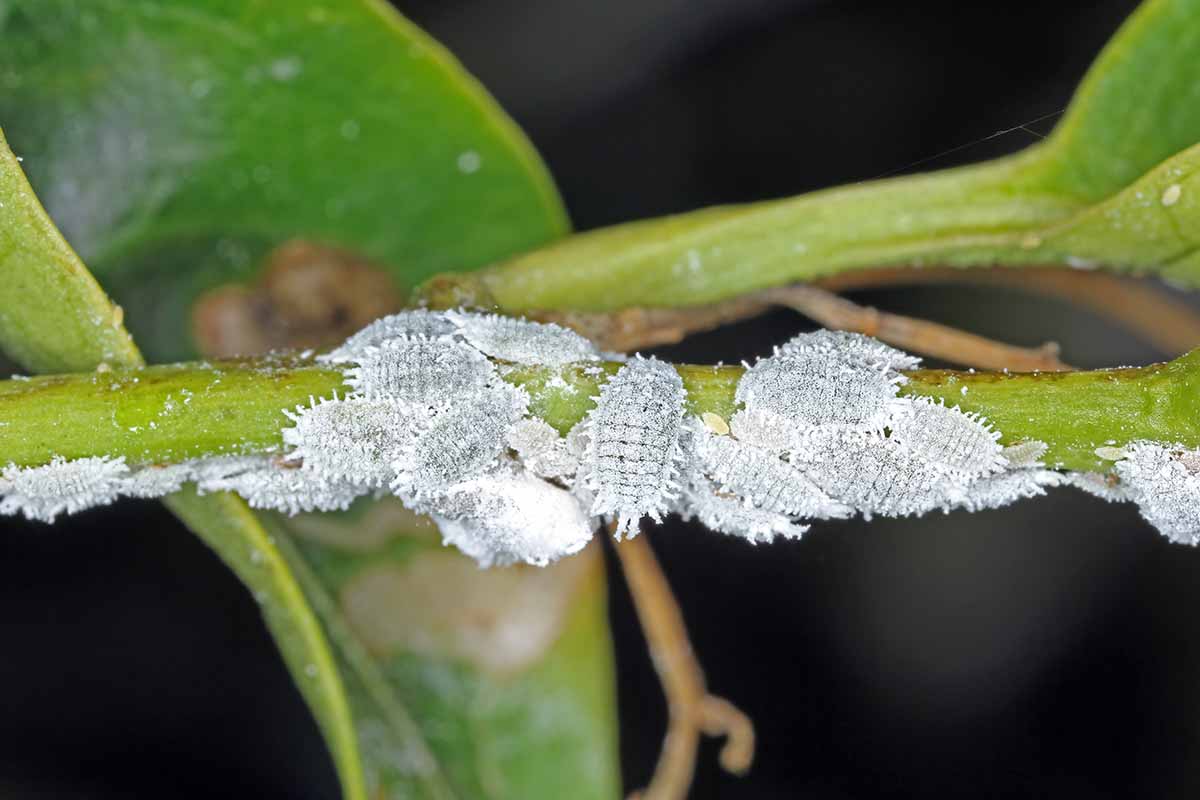
You’ll find them hiding on the undersides of the pansy foliage, along leaf veins, where they cluster like aphids and look like little tufts of grayish-white cotton wool.
The excretions of mealybugs will likely lead to an outbreak of sooty mold fungus.
Symptoms of feeding include plant decline and leaf drop. Treatment is challenging due to the waxy protective coating on their bodies and the pests’ habit of hiding.
Cultural Controls
Avoid overfertilizing, especially with nitrogen-rich products that produce the lush, new growth mealybugs prefer.
Maintain moisture to avoid overly dry conditions.
Mechanical Controls
Spray your pansies firmly with the garden hose to dislodge the insects.
Organic Controls
Azadirachtin kills mealybugs in all life stages, and products containing Beauvaria bassiana are also effective.
Horticultural oils, like neem, kill mealybugs and insecticidal soaps may help to reduce populations.
Bonide® Insecticidal Soap is a multi-purpose organic product derived from plant-based potassium fatty acids.
Bonide® Insecticidal Soap is available from Arbico Organics in 12-ounce and 32-ounce ready-to-use spray bottles.
Predatory insects that aid in eradication include lacewings, ladybugs, parasitic wasps, and pirate bugs.
The mealybug destroyer, Cryptolaemus montrozeuri, is the most effective ladybug species.
Chemical Controls
Isopropyl alcohol may prove an effective treatment for a small-scale infestation in a potted pansy plant. Dip a cotton swab into the rubbing alcohol and gently wipe away the pests.
Systemic pesticides containing dinotefuran, a neonicotinoid or synthetic nicotine-like compound, make foliage toxic to feeding mealybugs.
They may prove more effective than treatments aimed at killing bugs on contact, but neonicotinoids are toxic to bees, beneficials that may feed on mealybugs, marine life, people, and pets.
Our guide to identifying and controlling mealybugs has more information.
6. Scale
Scale are sapsucking insects that prefer hot, dry conditions.
They have a waxy covering or “scale” over their bodies that may be hard, aka armored, or soft, like the mealybug. There are many different types.
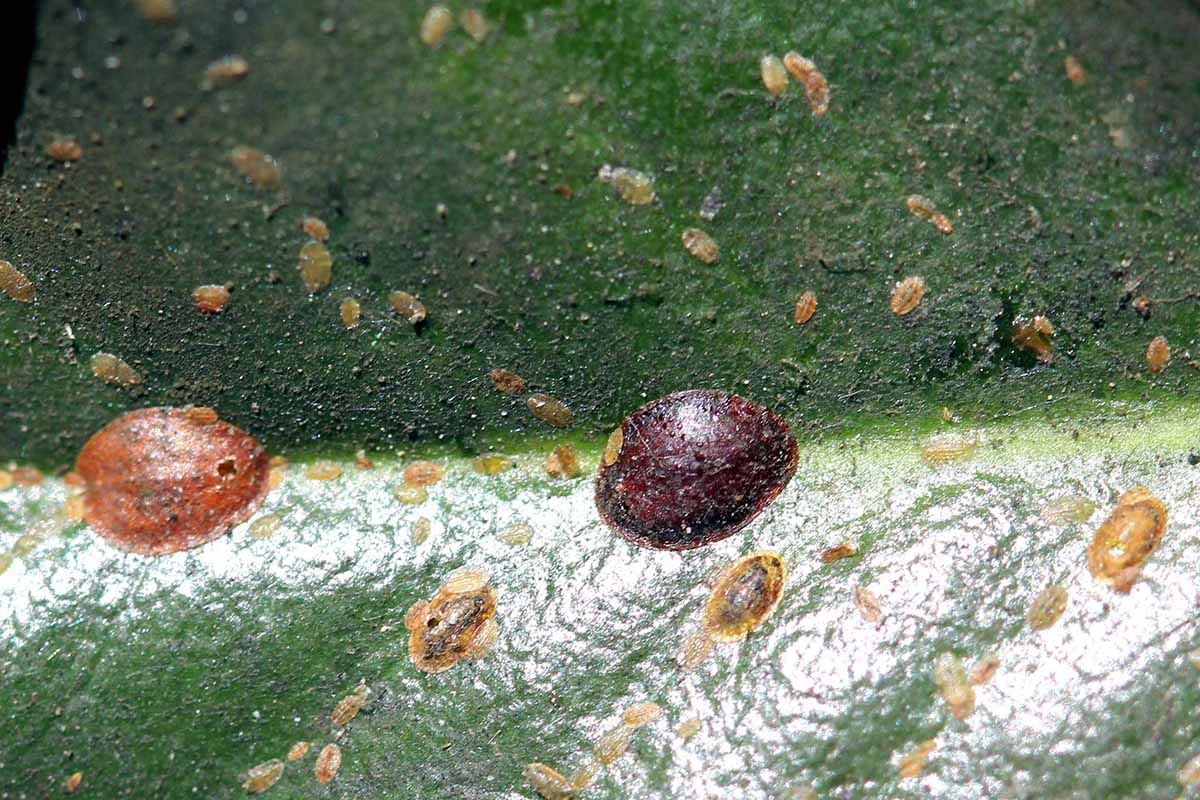
Brown soft scale, Coccus hesperidum, is a common pest, particularly in commercial greenhouse settings. Unlike hard scale, soft types excrete honeydew, rendering flora vulnerable to sooty mold.
Scale damage includes foliar yellowing, wilting, and decline. Despite the name “soft,” both have hard, waxy shells that many pesticides can’t penetrate.
The best time to treat is when the “crawlers” or juveniles emerge, but they are too tiny to see with the naked eye.
Cultural Controls
Avoid underwatering and dry conditions.
Mechanical Controls
Use your fingernail or a knife to scrape them off your pansy plants if you only see a few. But beware: the shells of hard scale may lift off, leaving the bodies behind. Scrape again.
The problem with this method is the likelihood of damaging the soft plant tissue of your pansies.
Alternatively, dab them with a cotton swab dipped in isopropyl alcohol.
Larger infestations can be sprayed with a mixture of one cup of isopropyl alcohol, one tablespoon of insecticidal soap, and one quart of water, according to experts at the Missouri Botanical Garden.
Organic Controls
Azadirachtin kills scale but as mentioned before is toxic to people, pets, marine life, and beneficials.
Parasitic wasps and lacewings that prey upon scale are best suited to a greenhouse setting.
Chemical Controls
Neonicotinoid insecticides like acetamiprid, dinotefuran, or thiamethoxam are effective, but best used as a last resort, as they are toxic to people, pets, and marine life, and beneficial insects.
Our scale identification and control guide has further details.
7. Slugs and Snails
Shell-less slugs and their voracious counterparts, spiral-shelled snails, are the most likely pests you’ll encounter because, like pansies, they prefer cool, moist conditions.
These hungry gastropods move by a muscular, foot-like appendage, creating telltale slime trails. They feed through the night on tender pansy foliage, leaving ragged holes.
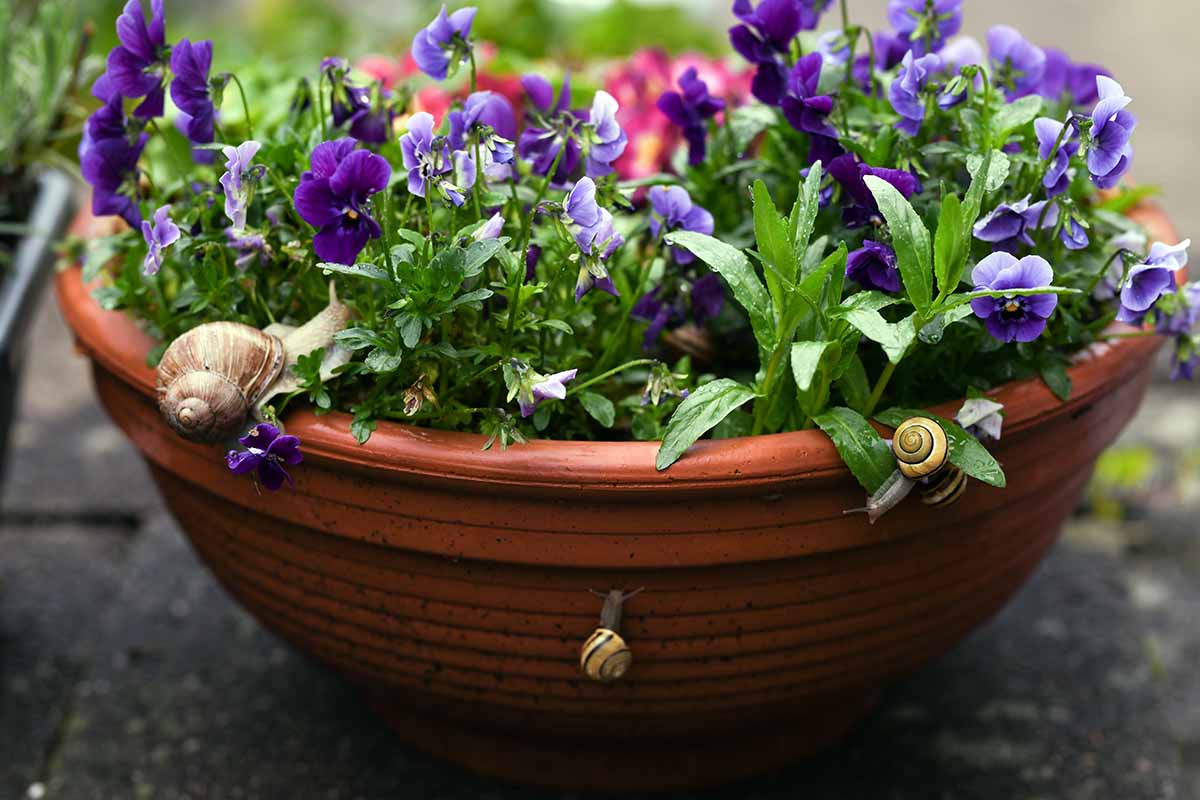
Gastropods thrive in humidity, laying eggs on moist soil and sheltering out of sight during the day.
In addition to fresh foliage, they feed on decaying flora, like grass clippings and fallen leaves.
Cultural Controls
Avoid overwatering and water your pansies early in the day so the ground is dry by the time the slugs are ready to feed.
If you use mulch, keep it shallow to avoid excessive moisture building up around the base of the plants.
Keep the garden area free of weeds where slugs and snails may spend the day.
Rake grass clippings and fallen leaves that may attract these pests and create desirable damp places beneath them.
Remove debris, like dead plant material, old mulch, and unnecessary articles, like empty flower pots. Gastropods winter over in such places as well as underground.
Space pansy plants well to avoid overcrowding, moisture buildup, and a lack of light penetration.
Mechanical Controls
Hand-pick slugs and snails from your pansies at night.
Place copper strips around plants. Make them wide enough to cause full body contact which causes an electrical shock. Thin strips gastropods can climb over are ineffective.
Set traps around your pansies, like a flower pot with one end raised, to capture gastropods for removal.
The Slug Saloon uses the included food-grade malted barley bait to lure and trap gastropods for easy disposal.
The Slug Saloon is available from Arbico Organics.
Choose from a single trap with a one-month bait supply; two traps with four three-month baits; a three-month bait refill; or a five-pack, three-month bait refill.
Organic Controls
Beneficial nematodes added to the soil in the cool spring and fall destroy eggs.
Ferric phosphate and spinosad products won’t harm beneficial insects, pets, or people.
Sluggo® combines ferric phosphate, spinosad, produced naturally by soil bacteria, and wheat gluten for bait.
Sluggo® is available from Arbico Organics.
Chemical Controls
Metaldehyde was formerly used in bait products but is now outlawed.
See our guide to slugs and snails for more information.
8. Spider Mites
Spider mites are arachnids, relatives of spiders that favor warm days with low wind. The two-spotted variety, Tetranychus urticae, is one of the most common.
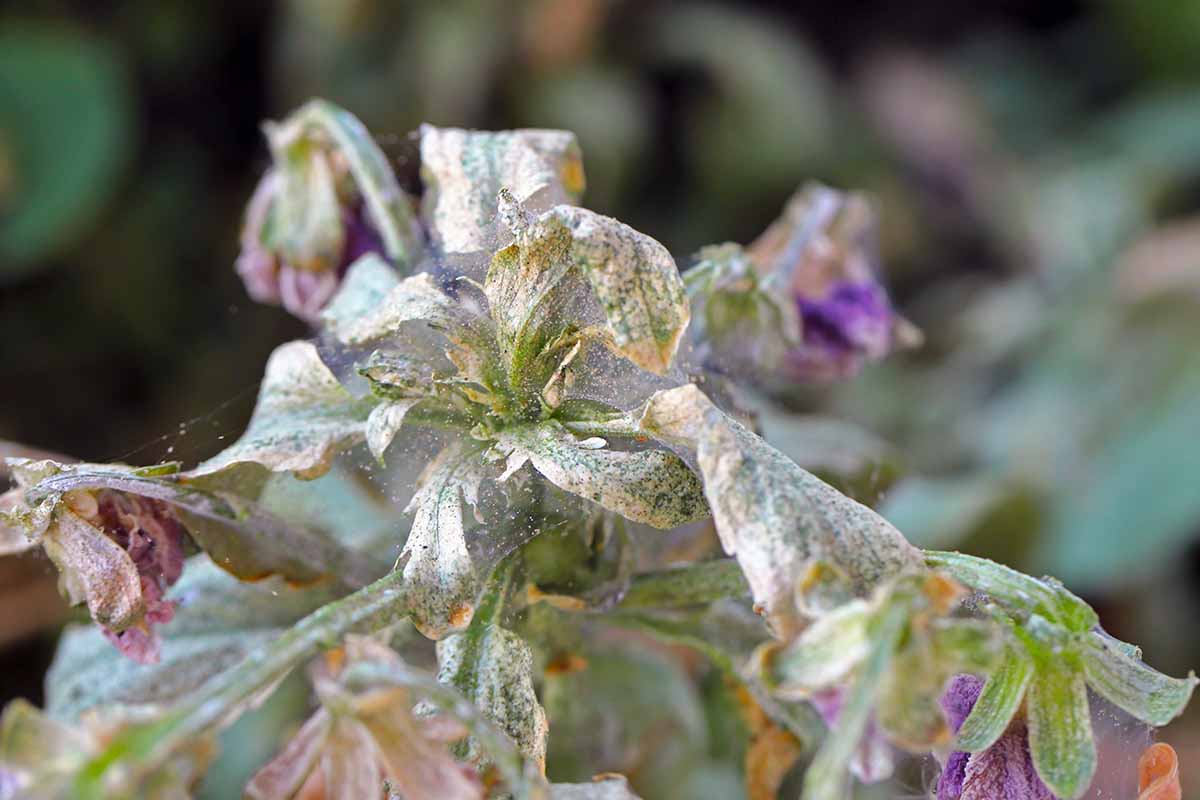
Tell-tale symptoms on your pansies include webbing, leaves with a bronze sheen, and stunted growth. Hot, dry, dusty conditions are conducive to infestation.
Cultural Controls
Avoid underwatering that causes moisture stress, weakening pansy plants and creating dry, dusty conditions.
Clear all garden debris to inhibit wintering over.
Mechanical Controls
Use a firm spray of water to disrupt the pests and dislodge them from the pansy plant. Wetting the foliage also helps to remove dust, another attraction for spider mites.
Organic Controls
Predatory assassin bugs, big-eyed bugs, lacewing larvae, ladybugs, mites, minute pirate bugs, and six-spotted thrips feed on spider mites.
Insecticidal soap and horticultural oil such as neem are also effective.
Pyrethrin-containing products kill spider mites in all life stages, but contain levels of toxicity harmful to beneficials that prey on spider mites, and marine life, pets, and people.
Chemical Controls
While some experts recommend the use of broad-spectrum pesticides containing malathion, bifenthrin, or cyfluthrin, they may not be the best chemical solutions because new spider mite strains are often pesticide-resistant.
Products containing the miticide kelthane are more likely to be effective because they specifically target mites.
These pesticides and miticides are toxic and may harm beneficials that feed on spider mites, marine life, people, and pets.
Our guide to the detection and control of spider mites has more information.
9. Whiteflies
Whiteflies are winged, sapsucking insects more closely related to the aphid and mealybug than the fly.
All life stages live on the undersides of leaves. When disturbed, the winged adults rise from the foliage like a puff of white powder.
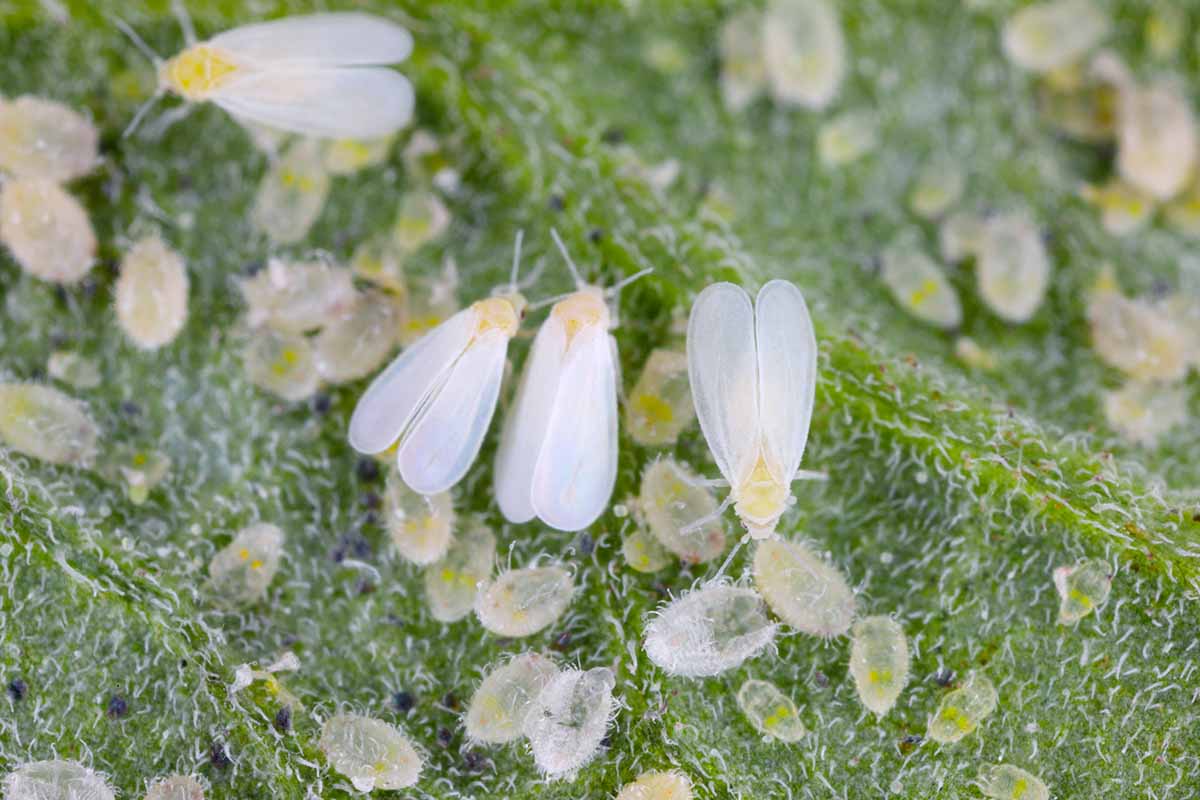
Telltale signs of their presence on your pansies include trails of honeydew, sooty mold, stunting, and wilting.
In advanced infestations, the leaves of the pansies may turn yellow and drop. Activity is exceptionally high in hot, dry, dusty environments.
Cultural Controls
Avoid overfertilizing, especially with a nitrogen-rich product that produces lush growth appealing to whiteflies.
Maintain even moisture to avoid creating dry, dusty conditions.
Use reflective copper or silver mulch around your pansies as a deterrent.
Mechanical Controls
Install bird yard features, like baths and houses, to attract smaller avian species, like chickadees and warblers, that feed on whiteflies.
Sticky traps may be all you need to address an early-stage infestation.
Spray a strong stream of water from the garden hose to dislodge pests from the pansy plants and moisten dry, dusty growing areas.
Organic Controls
Azadirachtin kills whiteflies in all stages and Beauvaria bassiana is an effective treatment.
Insecticidal soap applied to the undersides of the leaves kills adults and nymphs, slowing down reproduction.
Neem oil may also reduce populations.
Parasitic big-eyed bugs, lacewings, ladybugs, and wasps prey on whiteflies.
Chemical Controls
Broad-spectrum synthetic neonicotinoid insecticides containing permethrin and imidacloprid may prove effective but are toxic to beneficials, marine life, people, and pets.
Similarly, synthetic organophosphate malathion treats whitefly infestations but is also toxic.
See our guide to identifying and controlling whiteflies for details.
Pest-Free Pansies
Let’s recap. Pansies are short-lived flowering perennials or annuals that are not especially pest-prone.
However, because the nine pests discussed may use pansies as a host for breeding, you may face an infestation at some point.
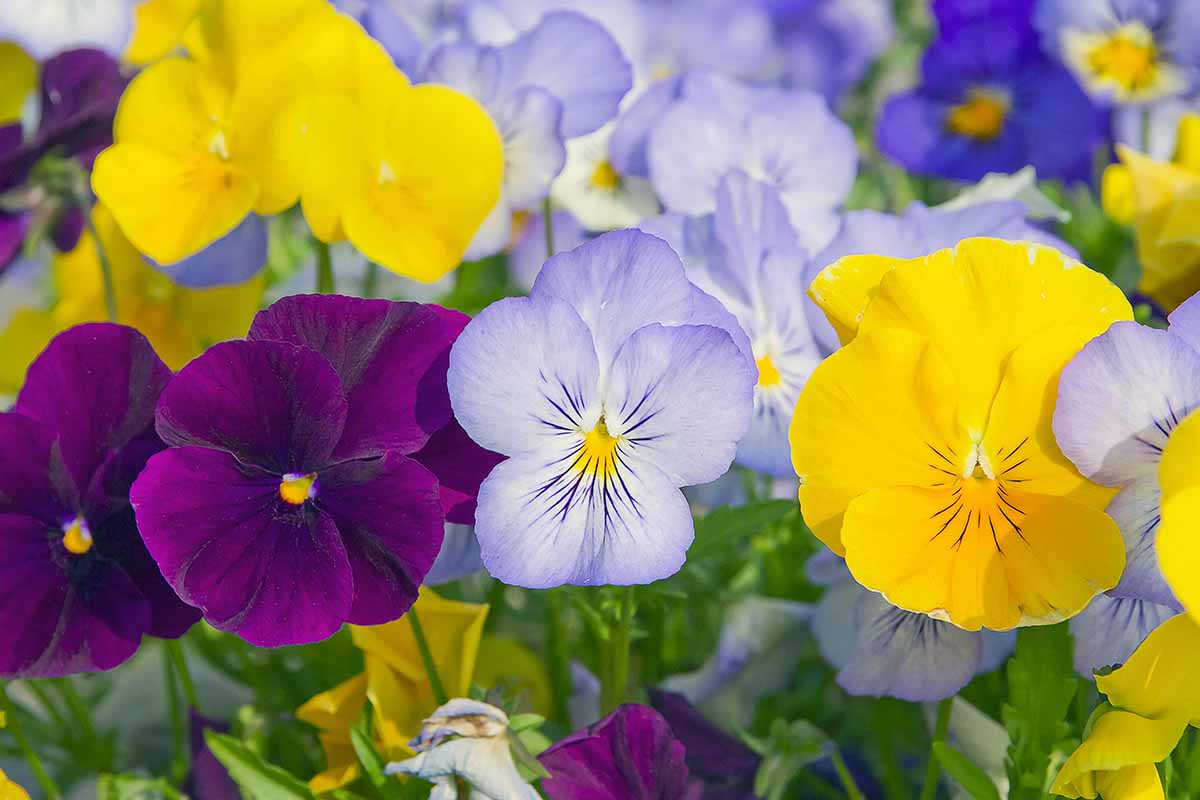
You now know about cultural, mechanical, organic, and chemical controls for avoiding pests and managing an outbreak.
Additional proactive steps include buying disease-resistant pansy seeds and plants, sanitizing all garden tools and yard shoes after use, and using insecticidal products per package instructions for safe, effective results.
Do you grow pansies? Have you dealt with pest issues? Please share your experience in the comments section below.
If you found this article informative and want to learn more about growing pansies, we recommend the following guides next:

